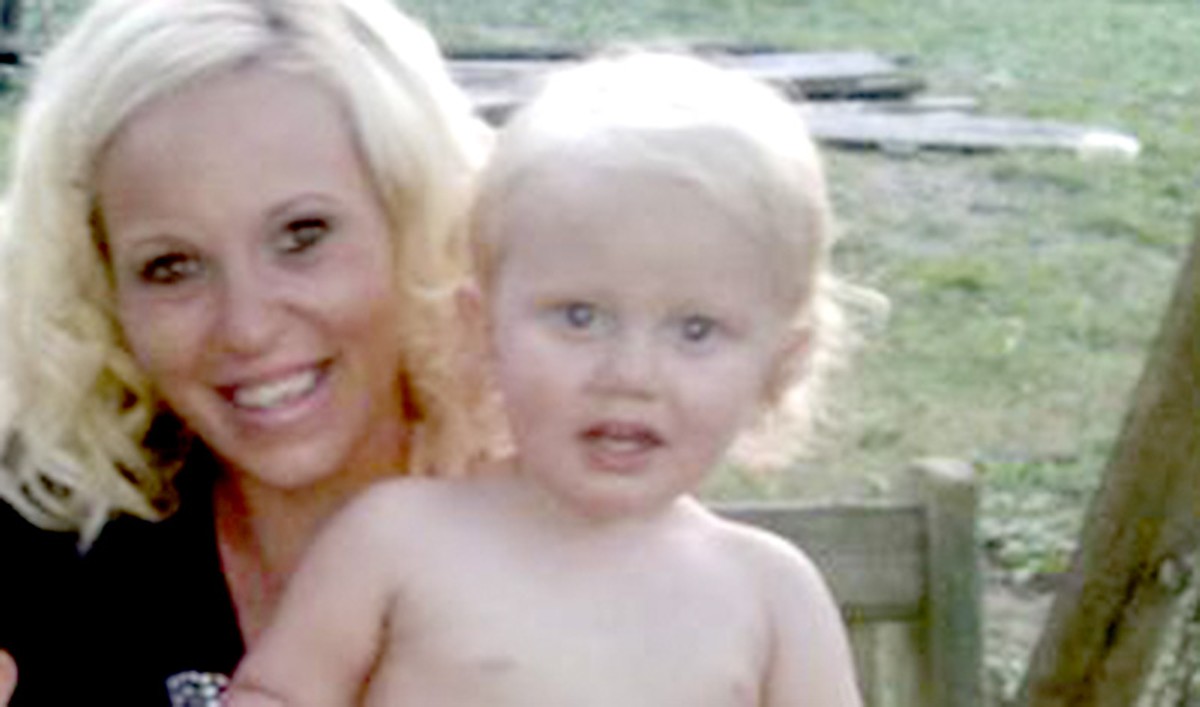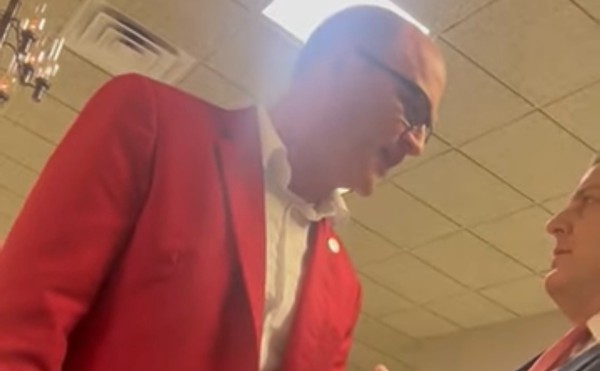There were other potential causes for conflict. The investigator repeated a story told by DeNoyer's uncle, who reported that both Amanda and Travis DeNoyer allegedly "made a trip to the grandmother's home and they baited Lacey out onto the porch and then Amanda physically attacked Lacey Kertz. Then they barged their way into the house and Amanda beat up Lacey Kertz. He states the children were present when this occurred."
Hamel's notes also show that Kertz texted her four times after the drop-in. Kertz's messages suggest that she appeared to regard the social worker as an ally in her custody battle, rather than someone investigating her for child neglect.
"Sorry to bother you ms.katherine but i really miss my little boy. Travis has a hostile temper. There are texts.and letters and reports to prove it..his wife used violence right in front of the kids. Punching me in the head...would this help? Maybe anger management...." In her last text, Kertz wrote: "Sorry this message is so late ...did you get ahold of my baby? Was he there? Is he okay?"
In an email to her supervisor, Hamel wrote: "The parents are going through a terrible custody issue at this time and the natural father has the child and is refusing to return him to the natural mother...I did not find any evidence of drug use by Lacey Kertz." Ten days later, Children's Division closed the case.
"That is the one that irritated me the most," Ross says. Kertz's flat denials of drug use and the suicide allegation should have been scrutinized, she says. Hamel could have asked for a drug test or spoken to neutral "collateral contacts," third-party sources with knowledge of a parent's history and character. The task force recommends investigators reach three collateral contacts, two non-relatives, if a parent has multiple abuse hotline calls in two years and the child is younger than six. Hamel's records list members of the Stadler family as collateral contacts.
The third call came in January 2013. This time, Clayton's father claimed that Kertz and Swyres had fondled the boy.
A forensic interviewer from the Missouri child assessment center spoke with Clayton, but determined the little boy had been coached. The report was labeled unsubstantiated and the case closed. Ross did not point to any red flags in this particular investigation. "I give a lot of credit to the expertise of the child assessment center," she says.
The fourth and final call came on July 12, 2013, three months before Carson's death.
By this time, Kertz had left the Stadlers' estate and was living with an older foster brother in Fredericktown. The caller repeated allegations that Kertz used drugs around her children and wrecked her car. "Lacey is always tired and sluggish. She is very skinny but eats," the caller reported. "Carson is up all night."
Investigator Tara McDonald showed up at the address two hours later. McDonald noted that Carson did not have any visible marks or bruises. "I observed a clean home with food, electric and operable plumbing," she wrote. McDonald later drove to DeNoyer's home. There, four-year-old Clayton told her he "feels safe at home and is not afraid of anyone."
McDonald called one collateral contact. Betty Helms told her "Lacey is not very mature but 'tries real hard,'" stating she did not believe her former foster child used drugs or alcohol. Using a point-based checklist called the Family Risk Assessment, McDonald marked a neglect score of "high." But Children's Division did not open a case.
Of the multiple investigations, Ross says, "It's sad. These poor kids. There were so many opportunities for someone to do something and nothing was done."
Ross chalks up the social workers' mistakes to inexperience. "We're talking about investigators who are often fresh out of college, in their first year or two of employment," Ross says. "They haven't had the time to develop good judgment skills." It's not an easy or financially rewarding job. Caseloads are high, hours are long and the work is emotionally draining. Entry-level investigators make less than $40,000 annually.
Owing in part to recommendations from the task force, Missouri's 2015 budget included funds for 23 additional service workers. The state also increased spending on training.
Kertz lost custody of Clayton on March 26, 2013, seven months before Carson's death. The loss sent her into a devastating spiral. "That's when I went off the fucking deep end," she says. Drug use increased. Her appearance changed; dark rings formed around her eyes and her jowl thinned out.
After she lost custody of Clayton, the Stadlers kicked Kertz out of their property. They allegedly caught her stealing pills from Stadler's husband. Kertz stopped contacting Helms and moved in with aunts and uncles for a couple of months, where she says she smoked meth when she couldn't get her hands on pills. She lived for a brief period with a former foster brother, but got kicked out after her drug use became a bad influence on his own teenage daughter.
In October 2013, she moved into the House Springs trailer with her biological dad and Carson.
Kertz and her dad, Politte, argued every day. "He had never been a dad to me, and now was not the time to start," she says. Neil Swyres, a frequent visitor, would drop off groceries; Kertz says he would drop off pills, too.
Within a month of moving into the trailer, Carson was dead.
When St. Louis City Chief Medical Examiner Dr. Michael Graham examined Carson's body, he determined the cause of death to be morphine intoxication. He also detected traces of amphetamine, meth and opiates in Carson's urine, but could not explain how the drugs entered his system. Carson appeared to be "a well developed, well nourished Caucasian child whose appearance is consistent with the stated age," he wrote.
Kertz's urine tested positive for morphine, and she admitted to consuming the same drugs found in Carson's system. In the 72 hours before Carson's death, according to prosecutors, Kertz had swallowed ten morphine pills, three or four Vicodins and a Xanax. Within 36 hours, she had also smoked "crumbs" of meth while her baby slept in the bedroom next door.
While doctors agree morphine can be passed through nursing, only small traces are typically detected in breast milk. Morphine metabolizes rapidly, explains Dr. Evan Schwarz, a toxicologist at Washington University. He tells the RFT, "With some exceptions, it would be unlikely for a baby, especially one older than a few months of age, to have very high levels of morphine only from nursing. In those situations, I'd be worried about another source of exposure."
In the hours after Carson's death, Children's Division investigated Kertz one last time, marking a "preponderance of evidence" of child neglect.
Carson Swyres's funeral was held November 4, one week after his death. Kertz made the arrangements. She assembled a photo collage of better times and designed a card that read, "Your footprints here on Earth will forever imprint our hearts." On a chilly morning, funeral-goers released dozens of balloons into the air; Carson had loved balloons.
The undertaker buried Carson in his Bob Bob pajamas. Kertz placed a key in his casket — the key, she says, to her heart.
In the months that followed, Kertz moved from home to home. As is often the case when tragedy and addiction meet, she sunk toward rock bottom. Kertz says her pill consumption catapulted, and she started smoking a gram of meth a day.
On December 20, 2012, the day her baby would have turned two, Kertz posted two photos to Facebook. In one, Carson basks in a ray of sunshine pouring through the window behind him. In the other, the little boy cracks a smile, his nose balancing a pair of purple-tinted sunglasses, worn upside down. Her caption reads: "Mommy would give her last breath to wake up to your kisses, watch you terrorize your cake, pop all of your balloons with your teeth...Around this time last year, you were learning to walk. Now, you're flying."
As Kertz descended deeper into depression, detectives continued to interview witnesses and gather evidence for the Jefferson County prosecutor. Between February and May, sheriff's deputies questioned members of Kertz's biological family, including her father, half-brother and mother, as well as Swyres. Their attempts to reach Kertz — a phone call, a home visit — were less successful.
But the DeNoyers and the Stadlers grew impatient with what they viewed as a delayed justice. In a segment that aired on KMOV, Travis DeNoyer told a reporter, "I want to know what happened to my little boy's brother because that's something he's going to have to grow with and he'll never see him again."
In April, Sheryl Sullivan and Judith Stadler appeared in a Post-Dispatch article headlined, "Women Want Charges in House Spring Toddler's Death." Photos of the two women kneeling next to Carson's grave accompany the text. The article describes Stadler clutching a Precious Moments angel that Carson "loved to cuddle with," and saying, "It's all I have left of him."
Kertz was astounded that the women she says "sold me the drugs that killed my baby" would express indignation in the region's largest newspaper. "What are you? Holier-than-thou?" she felt.
The dislike went both ways. "There was a point I wanted her dead," Sullivan tells the RFT.







